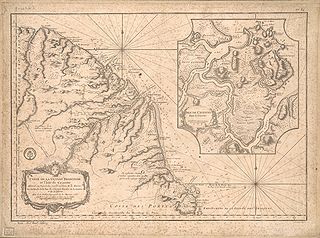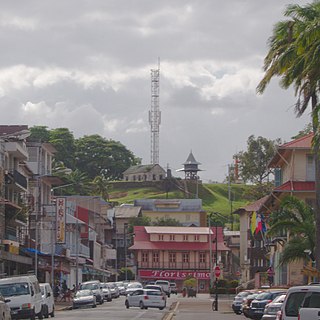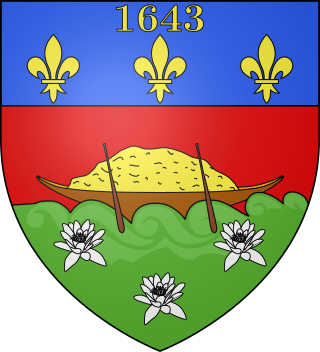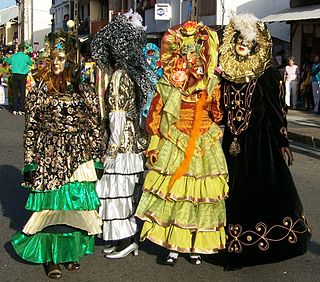Related Research Articles

The history of French Guiana dates back to the period prior to European colonization. Prior to the arrival of the first Europeans, there was no written history in the territory. It was originally inhabited by a number of Native American peoples, among them the Kalina (Caribs), Arawak, Galibi, Palikur, Teko, Wayampi, and Wayana. The first Europeans arrived in the expeditions of Christopher Columbus, shortly before 1500.

Transport in French Guiana consists of transport by road, boat, bus, and airplane. There is a railway line within the Guiana Space Centre to transport spacecraft. The road network is mainly concentrated in the coastal region. The interior of Guiana is accessed by plane or boat. There is one main airport, however there are several smaller airstrips in the interior.

Kourou is a commune in French Guiana, an overseas region and department of France in South America. Kourou is famous for being the location of the Guiana Space Centre, the main spaceport of France and the European Space Agency (ESA). It is an administrative district in French Guiana and the main town there.

The Guiana Space Centre, also called Europe's Spaceport, is a spaceport to the northwest of Kourou in French Guiana, an overseas region of France in South America. Kourou is located approximately 500 kilometres north of the equator at a latitude of 5°. In operation since 1968, it is a suitable location for a spaceport because of its near equatorial location and open sea to the east and north.

Cayenne is the prefecture of French Guiana, an overseas region and department of France located in South America and its capital city. The city stands on a former island at the mouth of the Cayenne River on the Atlantic coast. The city's motto is "fert aurum industria", which means "work brings wealth". Cayenne is the largest Francophone city of the South American continent.

Sinnamary is a town and commune on the coast of French Guiana, between Kourou and Iracoubo. Sinnamary was the second French settlement founded in French Guiana: the town was founded in 1664.

The 3 arrondissements of the Guyane department are:
- Arrondissement of Cayenne, with 10 communes. The population of the arrondissement was 180,493 in 2021.
- Arrondissement of Saint-Georges, with 4 communes. The population of the arrondissement was 8,557 in 2021.
- Arrondissement of Saint-Laurent-du-Maroni, with 8 communes. The population of the arrondissement was 97,568 in 2021.

The arrondissement of Cayenne is an arrondissement of France in the French Guiana department in French Guiana region. It has 10 communes. Its population is 180,493 (2021), and its area is 17,029 km2 (6,575 sq mi). It is the smallest of the three arrondissements in French Guiana, but also its most populated.
Météo-France is the official French meteorological administration, also offering services to Andorra and Monaco. It has the powers of the state and can exercise them in relation to meteorology. Météo-France is in charge of observing, studying, and forecasting weather and monitoring snowpack. The organization also issues weather warnings for the Metropole and the overseas territories. Météo-France is also in charge of recording and predicting the climate.
The French Guiana Régional 1 is the highest tier of men's football in French Guiana. It was created in 1961 and is organized by the Ligue de Football de la Guyane. There are twelve participants in the league, with teams finishing in the two bottom spots being relegated to the Régional 2. The division is equivalent to the sixth tier of football in France, the Régional 1.
The Coupe de Guyane is the top knockout tournament of the French Guiana football.

French Guiana is an overseas department and region of France located on the northern coast of South America in the Guianas and the West Indies. Bordered by Suriname to the west and Brazil to the east and south, French Guiana covers a total area of 84,000 km2 (32,000 sq mi) and a land area of 83,534 km2 (32,253 sq mi).As of January 2024, it is home to approximately 295,385 people.

The University of French Guiana is a French public university, created in 2014 in French Guiana. It was formed from two existing campuses of the University of the French West Indies and Guiana.

The Touloulou is the most famous of the typical characters and the queen of Guianan carnival.
The COVID-19 pandemic was confirmed to have reached the French overseas department and region of French Guiana. The first five cases were found on 4 March and the first death was announced on 20 April 2020. On 30 April, the territory was green listed, because the pandemic appeared to be under control except for Saint-Georges. In June, the virus started circulating all over the territory.

Marie-Laure Phinéra-Horth is a French politician, who was the first woman from French Guiana to be appointed to the French Senate in 2020. Prior to her role as a senator, she was mayor of Cayenne from 2010.

Davy Rimane is a French politician and labor activist. Rimane was elected to represent French Guiana's 2nd constituency in the 2022 French legislative election. He had previously contested the seat in the 2017 legislation election as well as the 2018 by-election.
As of 2018, there are 440 kilometres of national roads, 408 kilometres of departmental road, and 1,311 kilometres of municipal roads in French Guiana. There is no motorway.

Guyane La Première, is a French overseas departmental free-to-air television channel that broadcasts from Remire-Montjoly. The channel can be seen throughout French Guiana. It is operated by the overseas unit of France Télévisions.
References
- ↑ "French Guiana: The part of South America facing a total shutdown". BBC News. 10 April 2017. Archived from the original on 8 April 2019. Retrieved 16 April 2019.
- 1 2 Flandrin, Antoine (March 31, 2017). "" En Guyane, on a aujourd'hui une révolution "participative" "". Le Monde. Archived from the original on April 2, 2017. Retrieved April 3, 2017.
- 1 2 "Protesters converge on space center as French Guiana's financial crisis worsens". The Japan Times. April 5, 2017. Archived from the original on April 6, 2017. Retrieved April 5, 2017.
- ↑ Carlier, Rémi (April 2, 2017). "Rockets in the jungle: Understanding French Guiana's social unrest". France 24.
- 1 2 Jouve, Arnaud (April 7, 2017). "Guyane: les raisons de la colère". Radio France International. Archived from the original on April 8, 2017. Retrieved April 8, 2017.
- 1 2 3 Breeden, Aurelien (March 27, 2017). "Strikes Shut Down French Guiana, With Effects Resonating in Paris". The New York Times. Archived from the original on March 31, 2017. Retrieved April 3, 2017.
- ↑ Combier, Etienne (March 27, 2017). "Comprendre la crise sociale en Guyane, en trois questions". Les Echos. Archived from the original on March 28, 2017. Retrieved April 3, 2017.
- 1 2 Marot, Laurent (March 27, 2017). "La Guyane paralysée par les mouvements sociaux". Le Monde. Archived from the original on October 10, 2017. Retrieved April 3, 2017.
- ↑ Marot, Laurent (March 22, 2017). "La Guyane en proie à des mouvements de blocage". Le Monde. Archived from the original on March 27, 2017. Retrieved April 3, 2017.
- 1 2 Pierret, Benjamin (March 26, 2017). "Guyane : Air France annule ses vols en raison du mouvement social". RTL. Archived from the original on March 28, 2017. Retrieved April 3, 2017.
- ↑ "Spaceport protest delays rocket launch in French Guiana". BBC News. March 21, 2017. Archived from the original on March 25, 2017. Retrieved April 3, 2017.
- 1 2 Henry, Caleb (April 3, 2017). "Eutelsat satellite returned to factory as French Guiana unrest continues". SpaceNews . Archived from the original on March 10, 2023. Retrieved April 4, 2017.
- ↑ "Violences, barrages, écoles fermées... la Guyane en pleine explosion sociale". Huffington Post. March 24, 2017. Archived from the original on March 28, 2017. Retrieved April 3, 2017.
- 1 2 3 4 "Guyane : manifestations historiques pour la "journée morte"". Le Point. March 28, 2017. Archived from the original on October 10, 2017. Retrieved April 4, 2017.
- ↑ "ViaSat's satellite launch delayed due to civil unrest in French Guiana". The San Diego Union-Tribune. April 3, 2017. Archived from the original on April 4, 2017. Retrieved April 4, 2017.
- ↑ "Guyane : la manifestation de revendication débute à Kourou". Le Figaro. April 4, 2017. Archived from the original on April 4, 2017. Retrieved April 4, 2017.
- ↑ "Guyane : les manifestants occupent le Centre spatial". Le Figaro. April 5, 2017. Archived from the original on April 5, 2017. Retrieved April 5, 2017.
- ↑ "Guyane : le Centre spatial guyanais occupé par des manifestants". La Croix. April 5, 2017. Archived from the original on April 5, 2017. Retrieved April 5, 2017.
- 1 2 "Les Guyanais réclament un plan de 3,1 milliards d'euros". Le Figaro. April 5, 2017. Archived from the original on April 5, 2017. Retrieved April 5, 2017.
- ↑ "Guyane: le Centre spatial libéré, le plan d'urgence validé". Le Point. April 5, 2017. Archived from the original on April 5, 2017. Retrieved April 6, 2017.
- 1 2 3 Fioriti, Joris (April 5, 2017). "Un policier "sérieusement blessé" en Guyane: un cap est franchi dans la contestation". La Voix du Nord. Retrieved April 8, 2017.
- 1 2 3 "Guyane : un policier "sérieusement" blessé, la contestation se durcit". Le Parisien. April 8, 2017. Archived from the original on April 8, 2017. Retrieved April 8, 2017.
- 1 2 "Guyane : incidents en marge d'un rassemblement devant la préfecture". Le Monde. April 8, 2017. Archived from the original on April 8, 2017. Retrieved April 8, 2017.
- ↑ "Guyane : le policier blessé a rencontré une délégation des 500 Frères à l'hôpital". Le Parisien. April 9, 2017. Archived from the original on April 9, 2017. Retrieved April 9, 2017.
- ↑ "Guyane. Les blocages maintenus, la pénurie guette". Ouest-France. April 7, 2017. Archived from the original on April 8, 2017. Retrieved April 8, 2017.
- ↑ "French Guiana protests end with agreement". France 24. April 22, 2017. Archived from the original on April 23, 2017. Retrieved April 24, 2017.
- 1 2 "Mouvement social en Guyane : Cazeneuve appelle au "calme" et au "dialogue"". Le Parisien. March 25, 2017. Archived from the original on March 28, 2017. Retrieved April 3, 2017.
- ↑ "French Guiana rejects France's €1 billion offer, demands 'special status'". France 24. April 2, 2017. Archived from the original on April 3, 2017. Retrieved April 3, 2017.
- ↑ "French Guiana protesters demand 'immediate' €2.5 billion aid package". France 24. April 3, 2017. Archived from the original on April 3, 2017. Retrieved April 3, 2017.
- ↑ Pennetier, Marine; Pineau, Elizabeth; Vey, Jean-Baptiste (April 3, 2017). "Paris refuses demand for 'unrealistic' 2.5 billion euro French Guiana aid package". Reuters. Archived from the original on April 4, 2017. Retrieved April 4, 2017.
- ↑ "Guyane: "La France nous met sous cloche pour protéger le secteur spatial"". L'Express. April 5, 2017. Archived from the original on April 5, 2017. Retrieved April 5, 2017.
- 1 2 "En réponse au gouvernement, le Medef guyanais appelle à la "levée des blocages"". Le Figaro. April 5, 2017. Archived from the original on April 5, 2017. Retrieved April 6, 2017.